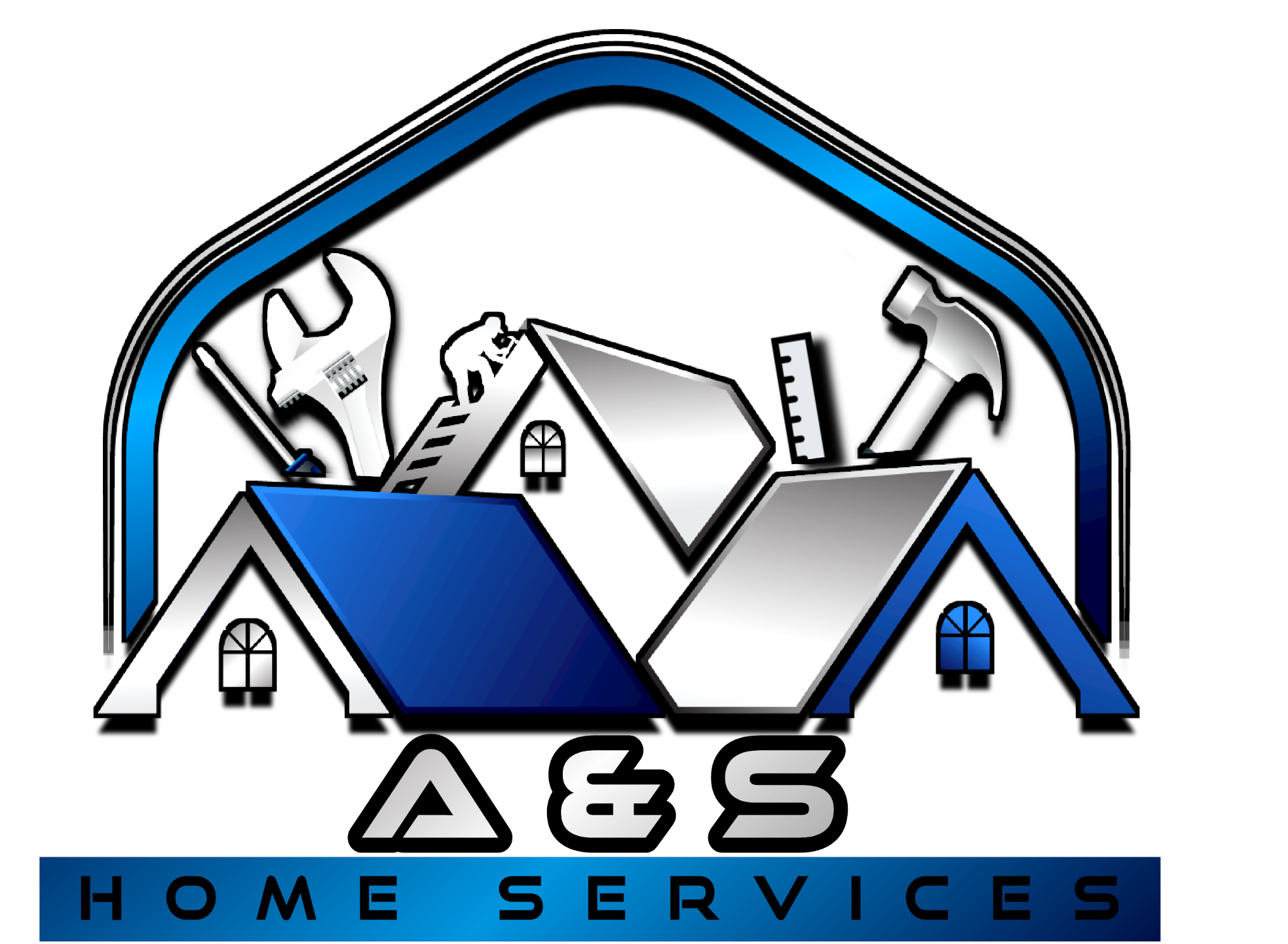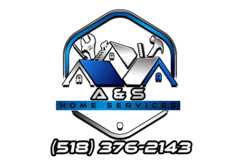Porch Steps & Railings: Repair, Safety, and Code Basics
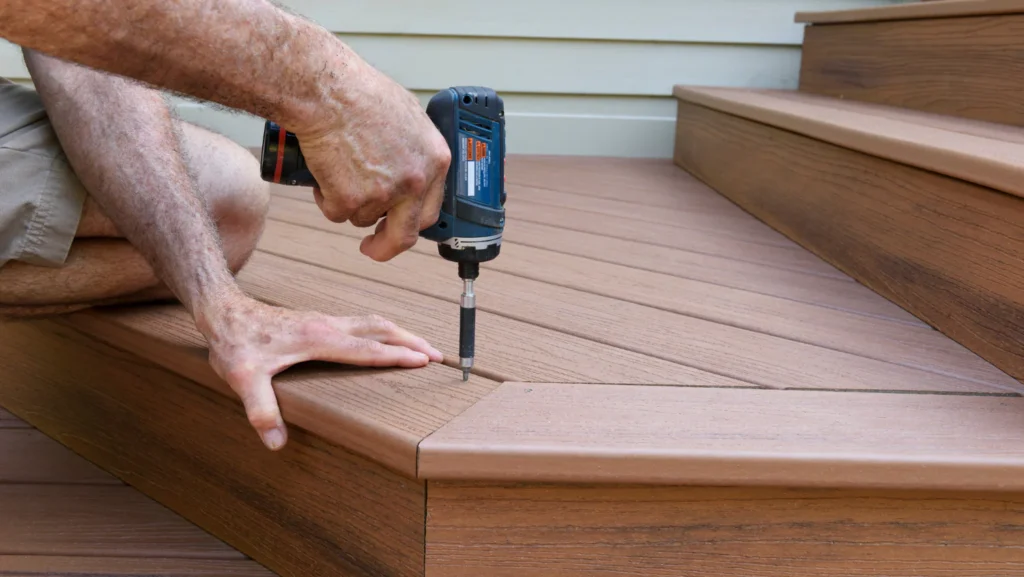
Summary
- You can prevent most porch step and railing failures with seasonal inspections and fast fixes.
- Know the basic code numbers for risers, treads, handrails, and guardrails before you start.
- Repair wood rot, loose anchors, and wobbly posts promptly to reduce fall risk.
- Use corrosion resistant fasteners and proper flashing to handle Albany winters.
- Call a pro for structural movement, major rot, or when permits and load calculations are required.
Introduction
Safe porch steps and railings protect your family, your guests, and your home value. In Albany, NY, repeated freeze and thaw cycles punish wood and concrete. Rail hardware loosens. Water sneaks into posts. Treads get slick. Small issues become big hazards fast. You can handle many repairs with the right plan and a careful approach.
This guide gives you clear steps for inspection, repair, and basic code compliance. You will learn what to fix now, what to monitor, and when to bring in a pro. If you prefer a professional from the start, A&S Home Services serves Albany homeowners with reliable porch repairs and safety upgrades.
Use the checklists, tables, and mini FAQs below to move quickly and safely from problem to solution.
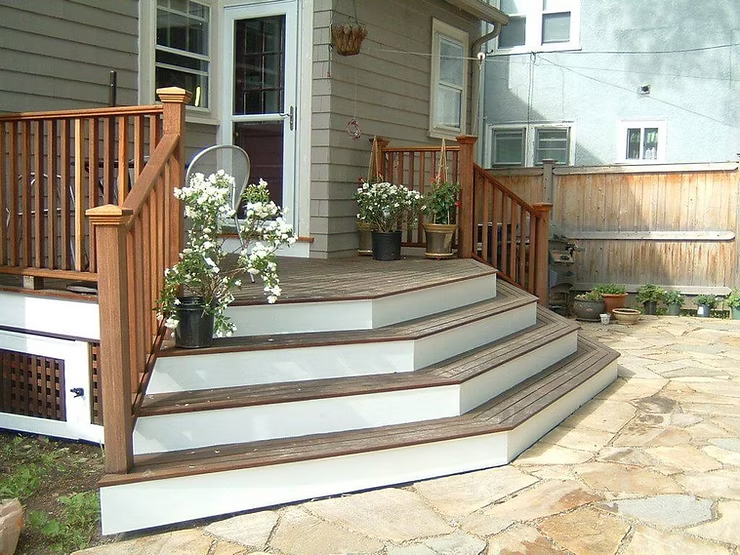
What are the most common porch step and railing problems you should look for?
Start with a simple visual and touch test. You are looking for anything that moves, cracks, holds water, or collects ice.
10-minute safety checklist
- Push and pull the handrail and guardrail. Any movement is a problem.
- Step on each tread at the front edge. Feel for spongy spots or bounce.
- Check riser heights with a tape measure. Consistent height reduces trips.
- Inspect post bases and stringer ends for rot, rust, or hollow sound.
- Look for loose, corroded, or missing screws and bolts.
- Check baluster spacing with a 4 inch block or tape. Over 4 inches is unsafe.
- Scan for cracks in concrete treads or landings, especially near edges.
- Look for peeling paint, soft wood, and green or black staining.
- Confirm that handrails are graspable and continuous on both sides for long runs.
- Note any ponding water on treads or landings after rain.
Quick problem and fix table
| Problem | Likely Cause | DIY Difficulty | Typical Fix |
|---|---|---|---|
| Wobbly handrail | Loose lag bolts, undersized anchors, wet rot | Moderate | Re-anchor with lag bolts or through bolts; add blocking; replace rot |
| Uneven risers | Settled landing, poor layout, warped wood | Moderate to high | Re-cut stringers or add shim tread; rebuild if variance exceeds code |
| Rot at stringer ends | Splashback, missing flashing, capillary moisture | Moderate | Cut out rot; install new pressure treated sections; add moisture break |
| Cracked concrete tread | Freeze-thaw, poor mix, thin section | Moderate | Patch with polymer-modified repair mortar; resurface if widespread |
| Loose balusters | Fastener corrosion, shrinkage | Easy | Replace fasteners; add adhesive; replace broken balusters |
| Slick treads | Algae, worn finish, ice | Easy | Clean, add grit strips, anti-slip paint, or treads |
What code basics apply to porch steps and railings in Albany, NY?
Albany follows New York State Residential Code based on the International Residential Code. Local amendments may apply. Use these common baseline values as a starting point and confirm with the local building department before major work.
Code quick reference
| Component | Typical Requirement | Why it matters |
|---|---|---|
| Riser height | Max 7.75 inches | Limits step-up effort and trips |
| Riser variation | Max 3/8 inch difference between tallest and shortest | Consistency prevents missteps |
| Tread depth | Min 10 inches measured horizontally | Gives safe foot placement |
| Nosing | 0.75 to 1.25 inches where used | Improves toe clearance |
| Handrail height | 34 to 38 inches above tread nosings | Comfortable, graspable support |
| Handrail grasp | Round 1.25 to 2 inches or equivalent graspable shape | Secure grip during ascent and descent |
| Guardrail height | Min 36 inches when fall exceeds 30 inches | Prevents falls from elevated porches |
| Baluster spacing | Less than 4 inches | Child safety |
| Landings | Min 36 by 36 inches at doors | Safe space to open and step |
| Lighting | Light required at exterior doors | Nighttime visibility |
If your existing stairs miss these targets by a small amount, treat them as a safety risk. If the variance is large, plan a rebuild and consider professional layout and installation.
How do you do a 5-minute porch safety test and score the risk?
Use this quick scoring tool. Any score above 6 means take action now.
| Item | Check | Score if failed |
|---|---|---|
| Rail movement | No movement under firm push | 3 |
| Riser uniformity | Variation 3/8 inch or less | 2 |
| Tread condition | No cracks, rot, or spongy areas | 2 |
| Baluster spacing | 4 inches or less | 2 |
| Anchor corrosion | No rust or loose bolts | 2 |
| Lighting | Bright, working fixture | 1 |
Risk graph
Higher bars mean higher risk. Fix the tallest bars first.
Which tools and materials do you need for the most common fixes?
| Task | Tools | Materials | Notes |
|---|---|---|---|
| Tighten loose handrail | Impact driver, drill bits, socket set, level | Structural screws or lag bolts, blocking, construction adhesive | Pre-drill to avoid splitting |
| Replace rotted tread | Circular saw, pry bar, square, measuring tape | Pressure treated lumber, exterior screws, stain or paint | Seal all cut ends |
| Re-anchor post base | Hammer drill, masonry bits, torque wrench | Concrete anchors, post base brackets, epoxy if specified | Follow anchor manufacturer specs |
| Repair cracked concrete | Chisel, wire brush, trowel | Polymer-modified repair mortar, bonding agent | Apply above 50 degrees F |
| Add anti-slip | Roller, brush, scissors | Grit tape, anti-slip paint with aggregate | Clean and dry surfaces first |
How do you tighten a loose handrail safely and correctly?
- Locate the structure. Find studs, stringers, or solid blocking behind the rail brackets.
- Remove old fasteners. Pull stripped screws. Scrape away loose wood fibers.
- Add blocking if needed. Open the underside or back side to install 2x blocking. Secure with structural screws.
- Pre-drill and re-anchor. Use appropriately sized lag bolts or structural screws into solid framing.
- Upgrade brackets. Use heavy duty exterior rated brackets. Avoid thin, stamped brackets for load areas.
- Seal penetrations. Apply exterior sealant around fastener heads to limit water intrusion.
- Test and finish. Apply firm lateral and vertical load. The rail should not move. Touch up paint or stain.
Safety tip: Wear eye protection and gloves. Keep drill torque under control to avoid snapping fasteners or stripping wood.
How do you replace a damaged wood step or tread?
- Measure accurately. Record total rise, tread depth, and nosing dimensions before removal.
- Remove the damaged tread. Use a circular saw to cut just shy of the stringers, then pry gently to avoid damaging the supports.
- Inspect stringers. Probe the stringer edges and ends. If they are soft, plan a stringer repair or replacement before installing new treads.
- Cut a new tread. Use pressure treated lumber or rot resistant wood. Match thickness and depth to maintain uniformity.
- Seal cut ends. Brush on end grain sealer or oil-based primer to limit moisture wicking.
- Fasten with exterior-grade screws. Pre-drill to reduce splitting. Use two screws per stringer per tread.
- Check level and nosing. Ensure the front edge is straight and consistent with adjacent treads.
- Finish. Apply exterior stain or paint with a non-slip additive. Allow full cure time before use.
If two or more treads are damaged, check riser uniformity. A multi-step repair is a good time to square and true the entire run to meet code and improve safety.
How do you repair a cracked concrete tread or landing?
- Clean and open the crack. Use a chisel to undercut the edges slightly so the patch locks in place. Brush out dust.
- Apply bonding agent. Follow the product instructions for timing and coverage.
- Mix repair mortar. Choose a polymer-modified product rated for thin repairs.
- Pack and smooth. Overfill slightly, then trowel to match existing pitch for drainage.
- Cure properly. Protect from rain and foot traffic as directed. Cold weather cures take longer.
For large delamination, shifting slabs, or recurring cracks, plan for a more comprehensive fix. Movement indicates a base or frost issue that simple patching will not solve.
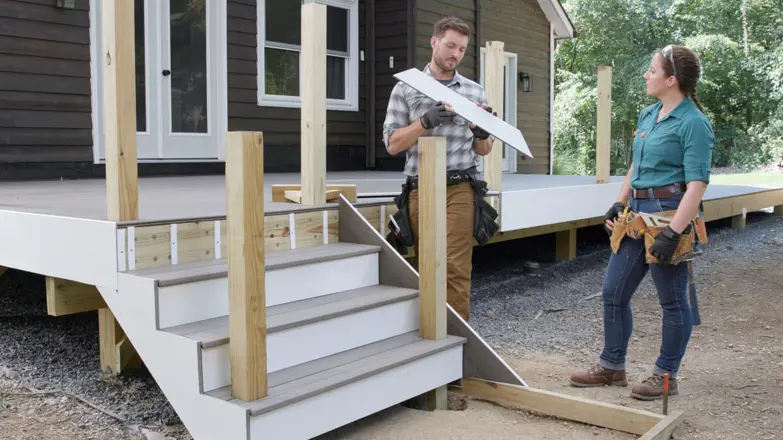
residential handyman services: When are they worth it?
Use this decision guide. If any of these apply, bring in a pro.
- Rails move at the post base or the post is splitting.
- Stringers are cracked, out of square, or rotted near the ground.
- Riser heights vary more than 3/8 inch and a rebuild is likely.
- The porch is more than 30 inches above grade and needs guardrails.
- Anchors must be set in concrete near the edge or epoxy anchors are required.
- You need permit guidance or layout changes for doors and landings.
Pros bring the right tools, code knowledge, and fast turnaround. This is especially valuable during Albany winter prep when weather windows are short. If you want broader context on choosing a local pro, read the Premium Guide to a Handyman in Albany, NY.
Which materials hold up best through Albany winters?
| Material | Pros | Cons | Best use |
|---|---|---|---|
| Pressure treated pine | Affordable, widely available, easy to work with | Can crack, needs sealing, checks over time | Treads, stringers, posts with good sealing |
| Cedar or redwood | Natural rot resistance, good appearance | Higher cost, needs regular finish | Rails, treads where aesthetics matter |
| Composite decking | Low maintenance, slip resistant options | Requires correct framing, higher cost | Treads and landings, especially shaded areas |
| Steel rail systems | Strong, slim profiles, durable powder coat | Can rust if coating is damaged | Handrails and guardrails |
| Aluminum rail systems | Corrosion resistant, light, easy kits | Higher upfront cost | Handrails and guardrails near water or snow |
| Concrete | Solid, long life, fire resistant | Can crack with freeze-thaw if poorly drained | Landings and monolithic steps |
Use corrosion resistant fasteners for all exterior work. Choose hot-dipped galvanized or stainless steel. Avoid mixing dissimilar metals that can corrode faster when wet and salty.
What routine maintenance keeps steps and railings safe and solid?
Seasonal plan
| Season | Tasks | Why |
|---|---|---|
| Spring | Wash surfaces, inspect for winter damage, tighten fasteners | Catch frost heave and corrosion early |
| Summer | Seal or paint, replace damaged treads, add anti-slip strips | Dry weather for coatings and repairs |
| Fall | Clear leaves, check lighting, add grit to high traffic steps | Prepare for ice and early darkness |
| Winter | Use calcium chloride sparingly, knock off icicles, monitor heave | Protect materials and maintain traction |
Maintenance priority graph
Focus on the highest bars during each season for best results.
If your schedule is packed, booking residential handyman services for a seasonal safety tune up can be cost effective. One visit can tighten rails, reseal cuts, add anti-slip, and flag code issues before they become urgent.
How much do typical porch step and railing repairs cost in Albany, NY?
Actual costs vary by design, access, and material. Use these local style ranges as planning numbers.
| Repair | DIY Material Cost | Typical Pro Cost Range | Notes |
|---|---|---|---|
| Tighten and re-anchor rail | $30 to $120 | $175 to $450 | Depends on bracket upgrades and blocking |
| Replace a single wood tread | $20 to $60 | $175 to $350 | Includes sealing and fasteners |
| Replace 3 to 5 treads | $80 to $200 | $450 to $900 | May need nosing or uniformity adjustments |
| Post base re-anchoring | $25 to $90 | $250 to $600 | Concrete anchors and brackets add cost |
| Concrete crack repair | $25 to $80 | $200 to $500 | Surface prep and cure protection matter |
| New aluminum rail kit, installed | N/A | $850 to $2,000+ | Price varies by length and style |
Compare the total of your time, specialized tools, and risk. For code sensitive or structural work, hiring residential handyman services often saves money by getting it done right the first time.
Do you need a permit for porch repairs or replacements?
Many simple repairs do not require a permit, but replacements and layout changes often do. In Albany, you should plan for a permit when:
- You rebuild stairs or change the number of risers and treads.
- You add or change guardrails or handrails on elevated porches.
- You alter structural supports, posts, or stringers.
- You pour new concrete landings or extend the footprint.
Call the local building department before major work. Have basic measurements ready and be ready to describe the location. Permits ensure safe installation and help when you sell the home. Pros can help prepare simple drawings and measurements to speed approval.
What safety habits reduce slips and falls on porches?
- Keep steps clean and dry. Sweep leaves and clear snow promptly.
- Use anti-slip treads or paint with grit on high traffic edges.
- Install bright, motion activated lights at entries.
- Repair movement and soft spots as soon as you find them.
- Salt only as needed to limit corrosion of metal parts. Use plant safe products.
- Test rails monthly by pushing and pulling with both hands.
Mini FAQ: Fast answers to common porch questions
How high can my porch be before I need a guardrail?
Guards are typically required when the drop is more than 30 inches. A 36 inch minimum guard height is common.
Do I need a handrail on both sides?
One continuous handrail is typically required on at least one side for stairs with four or more risers. Two rails improve safety.
What is the best anti-slip for wood steps?
Grit tape on the leading edge plus a non-slip coating provides the best traction with easy maintenance.
Can I sister a cracked stringer?
Yes, if the crack is minor and you add a full length sister with proper fasteners. For deep cracks or rot, replace the stringer.
How long do aluminum railings last?
Often 20 years or more with minimal maintenance. Touch up any scratches to prevent corrosion at fasteners.
Where can you learn more about hiring and scope of work?
Choosing the right help is easier when you know what to expect. Start with these helpful reads:
- Premium Guide: Handyman Albany, NY explains how to evaluate quotes, scheduling, and seasonal timing in the Capital Region.
- What kind of services does a handyman provide outlines typical tasks, limitations, and when you may need a licensed trade.
Conclusion
Porch steps and railings deserve regular attention. Check for movement, measure for uniformity, and seal against Albany weather. Follow the basic code dimensions for risers, treads, and rail heights. Fix small issues fast to avoid bigger repairs. When the work involves structural members, anchoring to concrete, or major layout changes, call a professional. For prompt help in Albany, A&S Home Services can inspect, recommend, and complete the right repair. Book a visit today and make your porch safe, compliant, and ready for all seasons.
This post has been published by Powerful Media Solutions. If you are looking for a marketing agency, please reach out.
